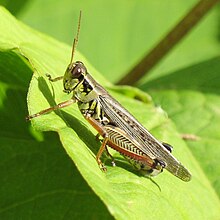| Melanoplus | |
|---|---|

| |
| Red-legged grasshopper (Melanoplus femurrubrum) | |
| Scientific classification | |
| Domain: | Eukaryota |
| Kingdom: | Animalia |
| Phylum: | Arthropoda |
| Class: | Insecta |
| Order: | Orthoptera |
| Suborder: | Caelifera |
| Family: | Acrididae |
| Subfamily: | Melanoplinae |
| Tribe: | Melanoplini |
| Genus: | Melanoplus Stål, 1873 |
| Species | |

Melanoplus is a large genus of grasshoppers. They are the typical large grasshoppers (and in some cases migratory "locusts") in North America. A common name is spur-throat grasshoppers (also "spurthroat" or "spur-throated grasshoppers"), but this more typically refers to members of the related subfamily Catantopinae.
The largest grasshoppers of this genus can reach nearly 5 cm (2.0 in) in length, but most are smaller. Some are intricately patterned and colorful, others are drab.
Melanoplus species eat grasses of all kinds, as well as leafy and grassy agricultural crops and garden plants. They feed on the leaves, and sometimes fruit, flowers, and buds, as well as tree bark. Many of the more notable agricultural pest grasshoppers belong here, including the Rocky Mountain locust, the most significant insect pest of the 19th century Great Plains, but now extinct.[1]
- ^ Samways, M. J. & Lockwood, J. A. (1998): "Orthoptera conservation: pests and paradoxes". Journal of Insect Conservation 2(3–4): 143–149. doi:10.1023/A:1009652016332 (HTML abstract)